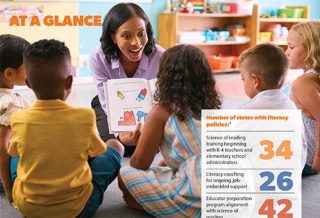FOCUS
A common aim unites a diverse community: ONLINE EXCLUSIVE
By Lauren Perez Pietruszka
Categories: Coaching, Data, Improvement science/networks, OutcomesApril 2023
Learning networks for school improvement are a powerful structure for educators to expand their knowledge and improve their practice, and when networks include members with diverse experiences and perspectives, the results can be particularly effective. But how can network facilitators ensure that members are learning from each other and collaborating on a shared problem to improve toward a shared purpose?
My colleagues and I at the Network for College Success have found that it’s essential to have a common aim that unites network members across diverse contexts and needs. Two years after introducing improvement science to our learning network, our partner schools in Chicago were struggling to document and share their practices that led to improved student outcomes reliably and consistently.
We hope that our insights can help others organize and facilitate networks, professional learning communities, and other collaborative learning structures in ways that are meaningful and beneficial for all participants.
The challenge
The Network for College Success formed the Freshman Success Improvement Community with 18 public high schools across Chicago to better support 9th graders during the pivotal first-year transition to high school. Building on our previous work and using research from the University of Chicago Consortium on School Research, our goal was to increase the number of students on track to graduate high school according to two indicators suggested by the consortium.
The first was the on-track rate, measuring first-year students earning at least five credits and no more than one F in semester grades for core courses. The second was 9th-grade students earning GPAs of 3.0 or better by the end of their first year. University of Chicago research found that GPA is an important leading indicator of college readiness, stating students who earn above a 3.0 GPA in high school are more than 50% likely to graduate from college (Network for College Success, n.d.).
Critically, high school GPA, not test scores, is the best predictor of college graduation. Therefore, students achieving 3.0+ GPAs at the end of 9th grade are more likely to also graduate high school with a 3.0+ GPA, increasing their post-secondary options and opportunities.
Our goals as an improvement community were to increase on-track rates to 95% and 3.0+ GPAs rates to 57% for all student groups across the network, particularly Latinx, Black, and English learner students.
As a learning network, we met four times a year and learned from one another by sharing challenges, strategies, and insights, with coaches facilitating the process. Determining a common focus for this community initially seemed obvious: supporting the least-reached 9th-grade students.
In the network’s first two years, schools continued their regular practice of analyzing data to determine a focus group of students whom they would follow carefully, but the makeup of those groups varied across schools. For example, many schools centered on Black and Brown boys, but others did not.
Schools shared practices that were working for their identified groups, yet other network schools were not implementing those shared practices reliably and consistently. There was a disconnect. The coaches, who are also educators, understood that we needed to pause to investigate our problem and system.
When we reflected on the network members’ conversations and learning, we began to recognize that differences among focus groups across the schools and their varying approaches to improvement were limiting educators’ ability to share practices and learn from each other. Their experiences were simply too disparate. As facilitators of the network, we faced a dilemma: How do we provide a common starting point for all network schools so that they could learn faster together while still supporting educator autonomy?
Finding commonality
We believed that targeting a specific group of students across the network would provide enough commonality for educators to share learnings across schools, zoom in on practices that would best support students to achieve high on-track rates and 3.0+ GPAs, and lead to more equitably transformed work across the network.
Using historic network data along with feedback from network members, coaches found that there were two groups of students underperforming at every school, regardless of school size and demographics. In past research, these groups have been referred to as “high-risk” and “vulnerable” (Network for College Success, n.d.).
The high-risk group was so named because of students’ risk of dropping out of high school. These students finished 8th grade with low attendance and low GPA and needed intensive support and interventions throughout 9th grade.
“Vulnerable” refers to students who are vulnerable to falling off track. This group finished 8th grade with high attendance but low to mid-GPAs, putting them in an academically precarious position that could lead to dropping out of high school.
Initially, we considered focusing on the high-risk group, but their low attendance rates and need for case-by-case interventions would limit the effectiveness of our efforts. We needed to start with a group that our educators could impact more consistently, so we chose the vulnerable group as our focus. Network members recognized the potential in this group of students, and they were galvanized by the opportunity to build on students’ strengths.
Once we identified a common target group, we identified a common aim. About 90% of the networks’ vulnerable students were considered on-track, which the Chicago Public Schools defines as having no more than one F grade in a core course for no more than one semester and having enough credits to be promoted to the 10th grade.
But network members wanted to move beyond these indicators of mitigating failure to the next level: supporting students to attain a 3.0+ GPA that would increase their chances of college graduation and post-secondary opportunities (Easton et al., 2017). At the end of the 2020-21 school year, only 26% of vulnerable students in the network schools were earning 3.0+ GPAs. For the 2022 school year, the network community set a goal of increasing that to 35%.
The shift to focus on a common, meaningful goal supporting a common group of students resonated with schools. Network members didn’t feel that their autonomy was compromised, and they were eager to go beyond sharing best practices or summarizing what they were doing. They wanted to share how and why a strategy was working with others who were testing the same strategy. And we quickly saw a difference in their improvement efforts.
After analyzing feedback and experience data from evaluations of network convenings, coaches noticed that educators who had shared their practice publicly during convenings or informally with others who were trying similar practices were more consistently using and embedding inquiry practices into their school teams, and those practices were gaining traction.
SMART goals for coaches
Until this point, the coaches had been the main facilitators and spreaders of learning across the network. But as network members’ learning ignited and inspiration spread, we needed to provide more opportunities for schools to learn from and collaborate with each other. We also recognized that we had to decenter ourselves and restructure spaces so that network members could lead and facilitate their own learning and collaboration.
To guide us, we drafted SMART goals (specific, measurable, attainable, results-based, and time-bound) for our own coaching over the next year. Just as the whole network had collaborated to determine a common aim, coaches collaborated to determine our specific goals:
By June 2022, 100% of school leaders in the network will report having collaborated with at least one other school leader within the network beyond network-sponsored events and calls.
By April 2022, school leaders will report increased comfort in sharing practices and learning from colleagues at other schools.
To achieve these goals, we knew that network members needed time and space to build trust. We built in time at every network convening for trust-building activities where members shared emotions and experiences in partners or small groups. These activities built up to sharing educational journeys, values and purpose, and identity markers.
This included substantial time for participants to reflect on their racial and cultural identities and their influence on leadership styles. This awareness of racial and cultural identities is essential not only for building trust, but also for educators to know themselves to be able to connect with the Black and Brown students they serve.
Facilitating these experiences required coaches to be intentional about building trust and collaboration among themselves and to refresh their routines and structures for doing so. Coaches met weekly for brief huddles (about 30 minutes) to build their own peer collaboration muscles.
During these sessions, coaches reflected on how and why their coaching practices supported successful improvement in schools. Being able to share and reflect with peers became a routine for coaches as well as network members as they studied what strategies were working and how.
Through these opportunities to reflect, be vulnerable, and share experiences, network members consistently reported stronger levels of trust and higher levels of collaboration not just within their school teams, but also with multiple schools across the network. As a result, network members shared more strategies and specific learnings consistently and promising practices were spreading, all grounded in the common aim shared across the network.
Ongoing support
With promising practices gaining traction, coaches provided support by coaching team leads and attending grade-level meetings at least every two weeks between convenings. These frequent touch points, in addition to the network convenings, created consistent opportunities to develop individual team leadership among the 9th-grade leads and provided space for those leads to increase their team’s capacity for learning and inquiry.
With this frequent support, 9th-grade leads were learning from other schools and sharing practices that were working at other schools with their teams. These practices included classroom routines such as executive functioning and actionable student feedback, and they also shared processes that increased team efficacy through identity reflections, shifting to asset-based language, and embedding continuous improvement practices to enact student supports and interventions. Team leads expressed excitement about building on others’ strategies while adapting them to their own contexts.
By the end of the 2022 school year, peer collaboration and trust across the network had increased. Members reported being three times more comfortable sharing their practice and learning with peers than they had the previous year. This led teams to share practices and engage in disciplined inquiry more consistently.
As a result, the network surpassed its goals for the vulnerable group in both freshman on-track indicators and 3.0+ GPAs. Our on-track indicators goal was 85% of target students, but 91% of students met the criteria. And 39% of students earned at least a 3.0 GPA, exceeding our goal of 35%. With a common target population, a common aim, and intentional trust building, we made more progress in collective learning than the individual members had made on their own.
As we look ahead to the 2023-24 school year, the Freshman Success Improvement Community continues to focus on vulnerable students but we have increased our goal to 45% of students achieving 3.0+ GPAs. The trust and collaboration routines established within the network continue to provide opportunities for educators to reflect on their practice and share their learning so that they can get to the heart of how and why a strategy is leading to improved experiences and outcomes for our students.
Continuing to deepen their levels of trust with themselves and each other also supports our 9th-grade leaders in exploring and understanding what is needed of them to continue transforming schools into thriving, equitable spaces for all young people.
Download pdf here.
References
Easton, J.Q., Johnson, E., & Sartain, L. (2017, September). The predictive power of ninth-grade GPA. University of Chicago Consortium on School Research.
Network for College Success. (n.d.). Ongoing research from the UChicago Consortium. Author. ncs.uchicago.edu/tool-set/ongoing-research-uchicago-consortium

Lauren Perez Pietruszka (perezpietruszka@uchicago.edu) is a Freshman Success improvement coach and data lead with the Network for College Success at the University of Chicago.
Categories: Coaching, Data, Improvement science/networks, Outcomes
Recent Issues
LEARNING TO PIVOT
August 2024
Sometimes new information and situations call for major change. This issue...
GLOBAL PERSPECTIVES
June 2024
What does professional learning look like around the world? This issue...
WHERE TECHNOLOGY CAN TAKE US
April 2024
Technology is both a topic and a tool for professional learning. This...
EVALUATING PROFESSIONAL LEARNING
February 2024
How do you know your professional learning is working? This issue digs...










